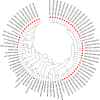Clinical, laboratory, and molecular epidemiology of Orientia tsutsugamushi infection from Southwestern India
- PMID: 37490497
- PMCID: PMC10368267
- DOI: 10.1371/journal.pone.0289126
Clinical, laboratory, and molecular epidemiology of Orientia tsutsugamushi infection from Southwestern India
Abstract
Scrub typhus is a vector borne disease which in a proportion of patients causes multiorgan involvement and death if untreated. Infecting genotype and virulence factors play a role in severity of infection and outcome. The current prospective cohort study was undertaken to elucidate the severity of illness in scrub typhus patients and to identify the circulating genotypes in Karnataka, India. A total of 214 patients of either gender from 9 districts of Karnataka and one patient each from Andhra Pradesh and Kerala, India were enrolled in the study. With a predefined severity criterion, 132 patients were segregated to the severe group. Multi organ involvement was seen in 59 (44.69%) patients. Phylogenetic analysis revealed JG-v like (48.97%), Karp-like (26.53%), JG-like (22.44%), and Kato-like (2.04%) strains in Karnataka. Patients infected with Orientia tsutsugamushi Karp-like strains had respiratory involvement (69.2%), cardiovascular involvement (46.2%) and thrombocytopenia (23.1%) and required higher hospital resource utilization.
Copyright: © 2023 Chunduru et al. This is an open access article distributed under the terms of the Creative Commons Attribution License, which permits unrestricted use, distribution, and reproduction in any medium, provided the original author and source are credited.
Conflict of interest statement
The authors have declared that no competing interests exist.
Figures



References
Publication types
MeSH terms
LinkOut - more resources
Full Text Sources

